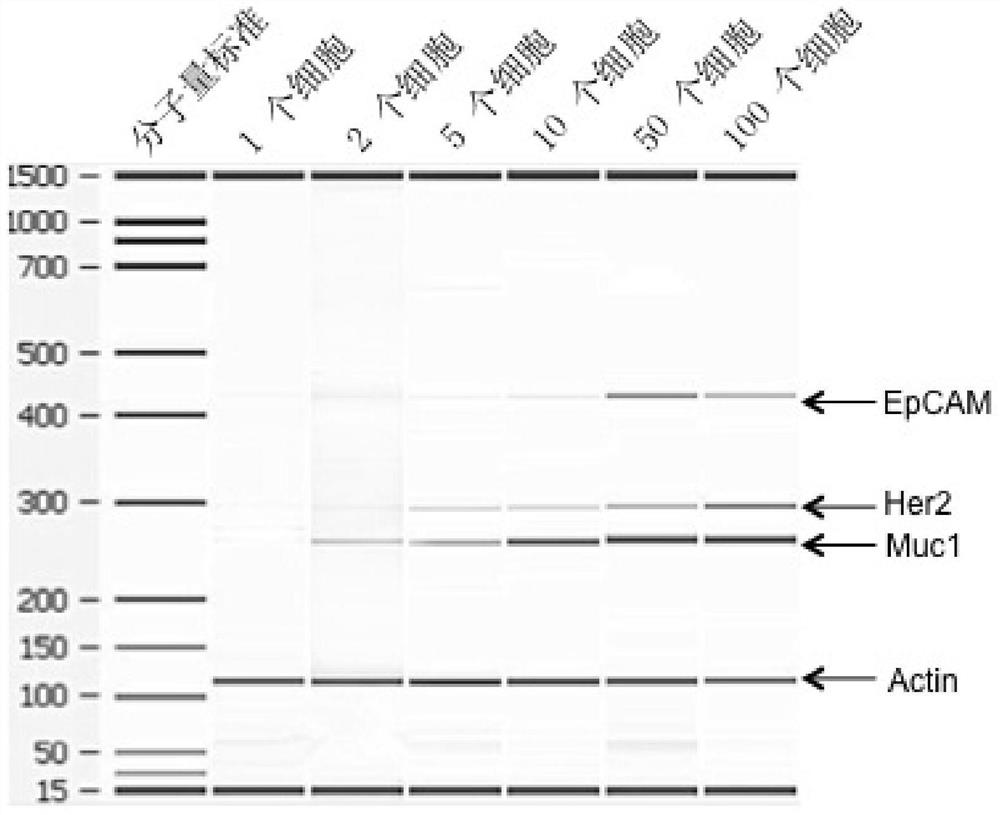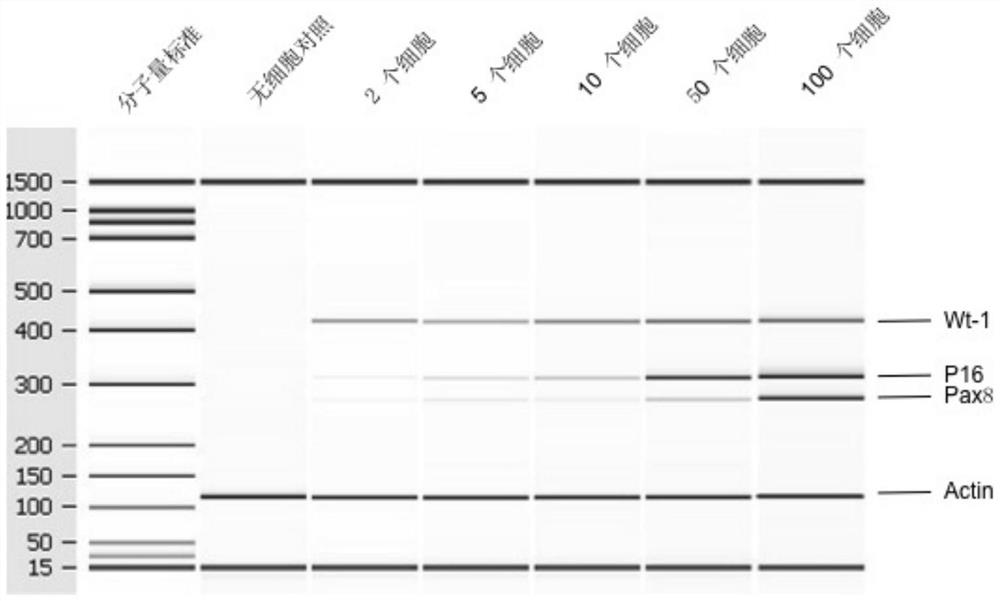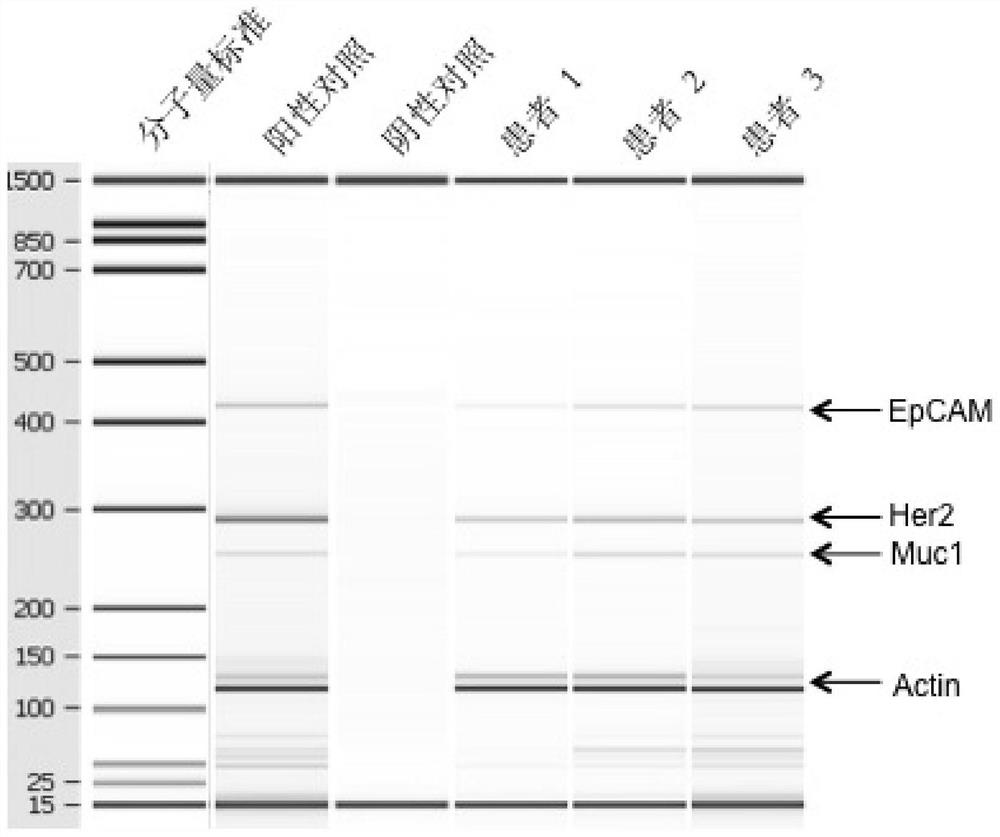A kit for detecting markers of ovarian cancer cells in peripheral blood
A technology of ovarian cancer cells and a kit, which is applied in the biological field and can solve the problems of being traumatic and unable to be used as an indicator for detecting tumor progress
- Summary
- Abstract
- Description
- Claims
- Application Information
AI Technical Summary
Problems solved by technology
Method used
Image
Examples
Embodiment 1
[0080] Example 1: Preparation of magnetic beads bound to ovarian cancer antibody:
[0081] Antibodies used were anti-EpCAM monoclonal antibody, anti-Muc1 monoclonal antibody and anti-Her-2 monoclonal antibody. This kit uses the above three antibodies to be labeled separately, and then they are mixed for use.
[0082] Labeling method: magnetic beads produced by Invitrogen, USA M-450Tosylactivated. The marking method is strictly in accordance with the product instructions.
[0083] The labeling ratio is: label 500 μL magnetic beads per 100 μg antibody, and mix in equal amounts after labeling.
Embodiment 2
[0084] Example 2: Isolation of ovarian cancer cells:
[0085] 2.1 Sample handling:
[0086] Take 5mL of peripheral blood from patients with ovarian cancer, anticoagulate with EDTA, store at 4 degrees, and use within 48 hours.
[0087] 2.2 Magnetic bead treatment:
[0088] Wash the magnetic beads bound with ovarian cancer antibody (antibody-labeled magnetic beads, which are mixed magnetic beads labeled with three antibodies, and prepare antibody-labeled magnetic beads according to the ratio of 1 mL sample to 25 μL magnetic beads) with PBS repeatedly for three times, and separate the magnetic beads. Beads, kept on ice;
[0089] The specific operation is: draw 125μL of marked magnetic beads into a 1.5mL centrifuge tube, gently blow and mix with a pipette (note that a vortexer cannot be used), and then place it on the magnetic bead enricher for 1min. , to attach the magnetic beads to the wall of the centrifuge tube, discard the supernatant; then add 1mL PBS, place it on the mag...
Embodiment 3
[0096] Example 3: Detection of ovarian cancer cell markers:
[0097] 3.1 mRNA purification
[0098] Mix 40 μL magnetic beads with oligonucleotide Oligo(dT) into a 1.5 mL centrifuge tube, add 500 μL lysis / binding buffer to wash twice, separate magnetic beads, add supernatant, mix well, and incubate at room temperature 10min, let the mRNA bind to the magnetic beads; then separate the magnetic beads, use 500 μL buffer A to wash the magnetic beads twice, separate the magnetic beads, then wash the magnetic beads twice with 500 μL buffer B, separate the magnetic beads, and then use 100 μL RNase- Wash once with free water, separate the magnetic beads, resuspend the magnetic beads with 29.5 μL RNase-free water, incubate in a water bath (or metal bath) at 55°C for 5 min, and place on ice for 2 min to obtain the mRNA / magnetic bead mixture.
[0099] The mRNA / bead mix cannot be stored and needs to be reverse transcribed immediately.
[0100] 3.2 Reverse transcription:
[0101] The revers...
PUM
 Login to View More
Login to View More Abstract
Description
Claims
Application Information
 Login to View More
Login to View More - R&D
- Intellectual Property
- Life Sciences
- Materials
- Tech Scout
- Unparalleled Data Quality
- Higher Quality Content
- 60% Fewer Hallucinations
Browse by: Latest US Patents, China's latest patents, Technical Efficacy Thesaurus, Application Domain, Technology Topic, Popular Technical Reports.
© 2025 PatSnap. All rights reserved.Legal|Privacy policy|Modern Slavery Act Transparency Statement|Sitemap|About US| Contact US: help@patsnap.com



